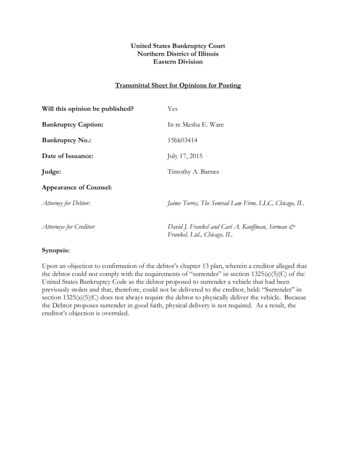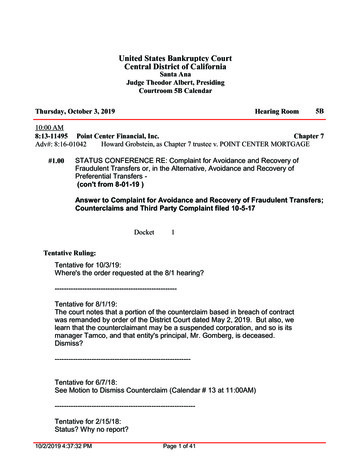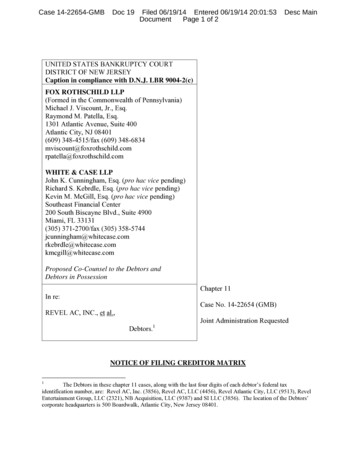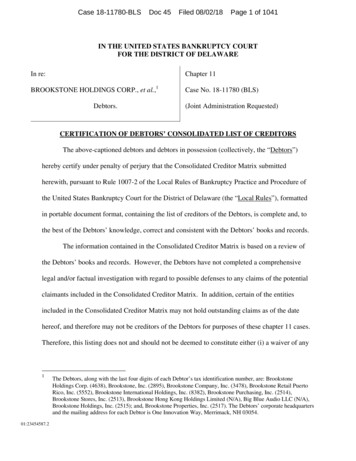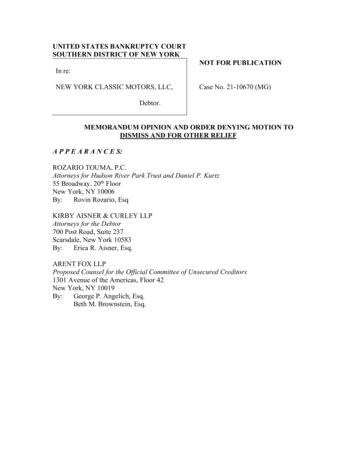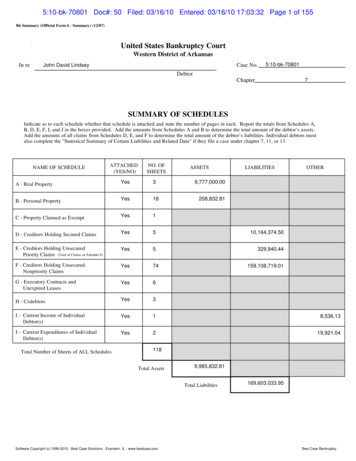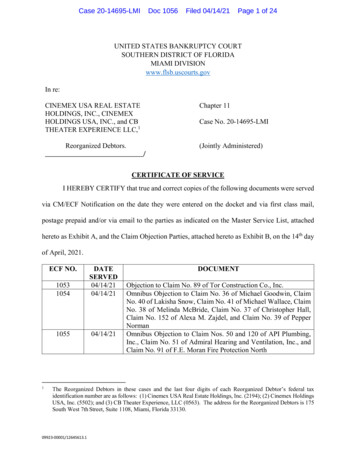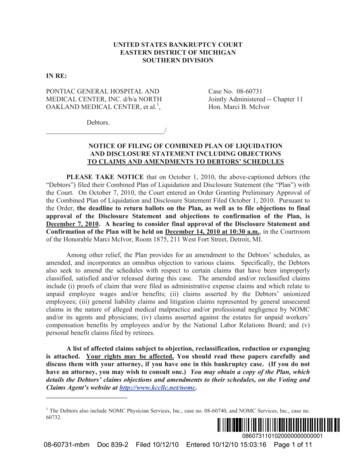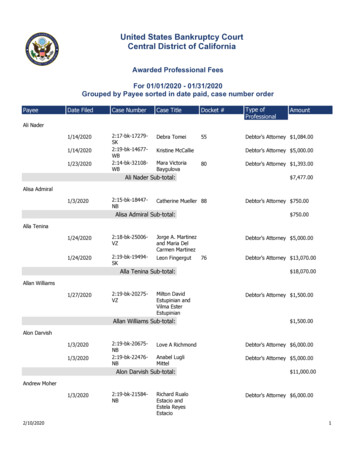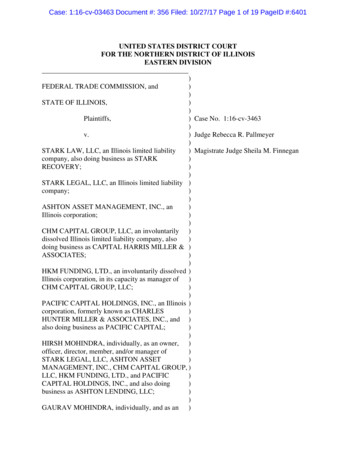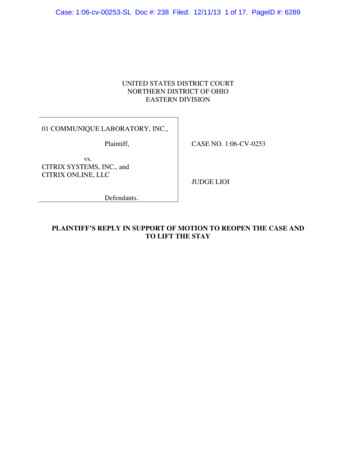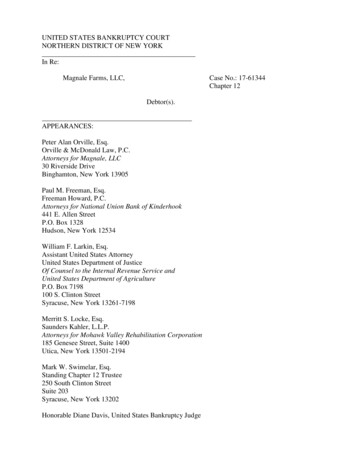
Transcription
UNITED STATES BANKRUPTCY COURTNORTHERN DISTRICT OF NEW YORKIn Re:Magnale Farms, LLC,Case No.: 17-61344Chapter 12Debtor(s).APPEARANCES:Peter Alan Orville, Esq.Orville & McDonald Law, P.C.Attorneys for Magnale, LLC30 Riverside DriveBinghamton, New York 13905Paul M. Freeman, Esq.Freeman Howard, P.C.Attorneys for National Union Bank of Kinderhook441 E. Allen StreetP.O. Box 1328Hudson, New York 12534William F. Larkin, Esq.Assistant United States AttorneyUnited States Department of JusticeOf Counsel to the Internal Revenue Service andUnited States Department of AgricultureP.O. Box 7198100 S. Clinton StreetSyracuse, New York 13261-7198Merritt S. Locke, Esq.Saunders Kahler, L.L.P.Attorneys for Mohawk Valley Rehabilitation Corporation185 Genesee Street, Suite 1400Utica, New York 13501-2194Mark W. Swimelar, Esq.Standing Chapter 12 Trustee250 South Clinton StreetSuite 203Syracuse, New York 13202Honorable Diane Davis, United States Bankruptcy Judge
MEMORANDUM-DECISION AND ORDERI. IntroductionPending before the Court is the March 8, 2018 motion of Debtor, Magnale Farms, LLC(“Debtor”), seeking entry of an order granting a stay pending appeal of this Court’s February 14,2018 order granting National Union Bank of Kinderhook (“Kinderhook”) relief from the automaticstay (the “Motion,” ECF No. 78). On February 8, 2018, the Court issued a Letter-Decision andOrder granting Kinderhook relief from the automatic stay pursuant to 11 U.S.C. § 362(d)(1) and362(d)(4) with respect to Debtor’s real property located at 434 Bed Bug Hill Road in Fly Creek,New York (the “Property”) (the “LDO,” ECF No. 63).1 The Court therein directed Kinderhook tosubmit a separate order that included a description of the Property and such other information asmay have been required by the Otsego County Clerk, which Kinderhook submitted and the Courtissued on February 14, 2018 (the “Stay Order,” ECF No. 65). For the reasons set forth below,Debtor’s Motion is denied.II. JurisdictionThe Court has subject matter jurisdiction over this core proceeding pursuant to 28 U.S.C.§§ 1334(a) and (b) and 157(a), (b)(1), and (b)(2)(A). The Motion is properly before this Courtpursuant to Federal Rule of Bankruptcy Procedure 8007(a)(1)(A).2III. Factual and Procedural BackgroundAs familiarly with the LDO and Stay Order is assumed, the Court will not restate thefindings of fact and conclusions of law set forth therein and will use all terms defined therein forconsistency. The Court notes that Debtor timely filed a Notice of Appeal on February 26, 2018(ECF No. 66), which does not divest this Court of jurisdiction to hear the Motion. See Fed. R.1All chapter and section references are to the United States Bankruptcy Code, 11 U.S.C. §§ 101–1532 (2012) (the“Bankruptcy Code”).2All rule references are to the Federal Rules of Bankruptcy Procedure.
3Bankr. P. 8007(a)(2) (“The motion may be made either before or after the notice of appeal isfiled.”).In support of the Motion, Debtor filed supplemental papers on March 21, 2018. (ECF No.85.) On March 22, 2018, Debtor filed a Certificate of Property Insurance dated February 1, 2018,showing proof of insurance issued by National Casualty Company naming Kinderhook as aCertificate Holder on blanket coverage for the building with a limit of 2,155,452.00, and on thepersonal property with a limit of 500,000.00 (the “COI,” ECF No. 88). On March 26, 2018,Debtor also filed a Certificate of Insurance and Declarations Page issued by National CasualtyCompany to Debtor for the coverage period of January 4, 2018, through January 4, 2019. (ECFNo. 92.) As stated in Debtor’s counsel’s correspondence, Kinderhook was added as a loss payeeto the COI on February 1, 2018.Kinderhook filed Opposition to the Motion on March 14, 2018 (ECF No. 83), which itamended on the same date (ECF No. 84). The Internal Revenue Service (“IRS”) and United StatesDepartment of Agriculture (“USDA”), on behalf of the Farm Services Agency (“FSA”), filed jointOpposition to the Motion on March 15, 2018. (ECF No. 84.)The Court heard oral argument on the Motion on March 22, 2018. Debtor, Mark W.Swimelar, Esq., as Standing Chapter 12 Trustee, Kinderhook, IRS, USDA, and Mohawk ValleyRehabilitation Corporation (“MORECO”) appeared through their respective counsels. Followingoral argument, the Court took the matter under advisement.IV. Arguments3In support of the Motion, Debtor’s arguments focus mainly on the parties’ respective harmsthat would result from this Court’s grant or denial of a stay pending appeal, as well as Debtor’sAlthough MORECO’s counsel, Merritt S. Locke, Esq., appeared and placed limited arguments on the record,MORECO did not file papers in support or in opposition to the Motion. To the extent Attorney Locke argued in favorof the Motion and a stay pending appeal, the Court has considered MORECO’s arguments and determined that theydo not alter the outcome of its decision.3
4ability to succeed on appeal. With respect to the former, Debtor contends that the LLC, its principaland sole member James Giombetti, and Mr. Giombetti’s wife would suffer irreparable harm in theabsence of a stay pending appeal because Debtor’s loss of the Property would render its appealmoot and result in the cessation of the business and loss of the Giombettis’ personal investment inthe Property. As to Kinderhook, Debtor asserts that a stay pending appeal and any resultant delayof Kinderhook’s foreclosure sale on the Property would not cause any harm to Kinderhook becauseit would be paid in full at the end of the reorganization process. With respect to the latter, Debtorargues that it will succeed on appeal because the Court’s § 362(d) ruling in Kinderhook’s favor ispremised on the following erroneous findings: (1) Kinderhook’s secured interest was notadequately protected and Kinderhook was entitled to relief under § 362(d)(1); (2) Debtor’s failureto comply with the Interim Order and failure to provide proof of insurance and property taxpayments constituted “cause” under subsection (d)(1); (3) Debtor proffered unrealistic projectionssuch that the Amended Plan was not feasible and confirmable as a matter of law; (4) Kinderhookwas entitled to in rem relief under § 362(d)(4)(B) because Debtor’s current case is part of a schemeto hinder or delay Kinderhook’s foreclosure efforts; and (5) Debtor does not have the means orability to reorganize by virtue of a confirmable plan and Debtor has not made any meaningfulprogress towards reorganization since it first filed Magnale I in 2015.To support its specific assertions of error, Debtor’s counsel again indicated on the recordthat Debtor is in the midst of negotiating replacement debtor-in-possession (“DIP”) financing witha new lender. Notwithstanding that Debtor did not have a firm commitment at the time, counselrepresented that the loan could likely close within two months. In addition, Debtor’s counseladvised that Debtor had obtained casualty insurance for the Property, with Kinderhook as a namedloss payee.
5Finally, Debtor argues that the Court procedurally mishandled Kinderhook’s § 362(d)motion and denied it due process by failing to conduct a full evidentiary hearing on confirmationof the Amended Plan and valuation of the Property.Kinderhook first contends that Ellis v. NBT Bank, N.A., No. 5:12-cv-01803 (MAD), 2013U.S. Dist. LEXIS 4318 (N.D.N.Y. 2013), is controlling because this matter is analogous to thefacts of that case. Kinderhook next contends that the counterbalancing of factors weighs against astay pending appeal in this case because Debtor cannot establish a substantial possibility of successon appeal, and a stay pending appeal would impose significant financial harm on Kinderhook.Kinderhook asserts that Debtor, as it has consistently done during the course of Magnale I,Magnale II, and Magnale III, relies upon mere conclusory statements or promises of new financing,without providing supporting factual evidence of its timely compliance with its existingobligations under the Bankruptcy Code or its future ability to successfully reorganize. Specifically,Kinderhook argues that the fact that equity may exist in the Property does not relieve Debtor ofthe obligation to make contractual mortgage payments to a secured creditor, as stated in In re Lord,325 B.R. 121, 129 (S.D.N.Y. 2005). Kinderhook also asserts that Debtor has not provided anylegal basis to excuse Debtor from timely complying with the Interim Order or its insuranceobligations. Kinderhook contends that, as of January 17, 2018, the arrearage on its debt totaledapproximately 740,000.00. This constitutes an increase of 497,528.39 since Debtor’s filing ofMagnale I in 2015.4 Accordingly, Kinderhook asserts that it will continue to suffer financial harmif the Motion is granted.FSA similarly contends that the Motion should be denied because Debtor cannot establisha substantial possibility of success on appeal. FSA contends that the Court’s grant of § 362(d)(1)relief was correct for the following reasons: (1) Debtor failed to timely make the adequate4This aggregate arrearage is taken from the Magnale I Claims Register; Proof of Claim Numbers 4 and 5.
6protection payment to Kinderhook as required by the Interim Order; (2) Debtor failed to provideproof of property and casualty insurance; (3) Debtor’s projections were unrealistic; (4) Debtorfailed to make regular monthly mortgage payments to Kinderhook; (5) Debtor failed to pay theannual real estate taxes in the amount of 22,000.00; and (6) Debtor failed to pay the annualproperty/casualty insurance premium of 41,000.00. Additionally, FSA points out that all three ofDebtor’s monthly operating reports showed miniscule income or continuing losses, with theselosses potentially being far greater had Debtor made or accounted for the mortgage payments,annual real estate taxes, and property insurance, which alone would have required a monthlypayment of 18,750.00. FSA also contends that the Court’s grant of § 362(d)(4)(B) relief wascorrect because Debtor did not appeal the dismissal of Magnale I, but rather filed the current caseas an impermissible collateral challenge to that dismissal.Both Kinderhook and FSA refute Debtor’s due process challenge. Kinderhook and FSAargue that Debtor has had more than enough time and opportunity to prove to the Court and to itscreditors that it could successfully reorganize. Notwithstanding, Debtor has failed to do so. In fact,Kinderhook and FSA suggest that Debtor cannot reorganize because Debtor’s business model and,by extension, its reorganization plan, are unworkable and fundamentally flawed.V. DiscussionA stay pending appeal “involves extraordinary relief and the discretion of the court.” In rePine Lake Village Apartment Co., 21 B.R. 395, 398 (S.D.N.Y. 1982) (citing Resident AdvisoryBoard v. Rizzo, 429 F. Supp. 222, 224 (D. Pa. 1977)). “Stays pending appeal are the exception, notthe rule, and are granted only in limited circumstances.” In re Taub, Chapter 11 Case No. 0844210-ess, 2010 Bankr. LEXIS 3458 (Bankr. E.D.N.Y. Oct. 1, 2010), at *7 (citing Licensing byPaolo, Inc. v. Sinatra (In re Gucci), 105 F.3d 837, 840 (2d Cir. 1997); In re Aston Baker, No. CV05-3487 (CPS), 2005 U.S. Dist. LEXIS 36969, at *10–11 (E.D.N.Y. Aug. 31, 2005)). A movant
7seeking a stay pending appeal under Rule 8007 bears the heavy burden of proving that it is entitledto a stay. In re Adelphia Commc’ns Corp., 333 B.R. 649, 659 (S.D.N.Y. 2005).In the Second Circuit, the standard governing the entry of a stay pending appeal iscomprised of four factors: (1) whether the movant will suffer irreparable injury absent a stay; (2)whether a party will suffer substantial injury if a stay is issued; (3) whether the movant hasdemonstrated a substantial possibility, although less than a likelihood, of success on appeal; and(4) the public interests that may be affected. Hirschfeld v. Board of Elections, 984 F.2d 35, 39 (2dCir. 1993) (internal quotation marks and citations omitted). As Kinderhook and FSA argue, anumber of lower courts within the Second Circuit have concluded that failure of the movant tosatisfy any one of the four factors on a motion for a stay pending appeal of a bankruptcy courtorder is fatal. See ACC Bondholder Group v. Adelphia Communs. Corp. (In re Adelphia Communs.Corp.), 361 B.R. 337, 346–47 n. 33 (S.D.N.Y. 2007) (collecting cases); accord Turner v. CitizensNat’l Bank (In re Turner), 207 B.R. 373, 375 (B.A.P. 2d Cir. 1997) (“Failure to satisfy one prongof this standard for granting a stay will doom the motion.”) (citing Bijan-Sara Corp. v. FederalDeposit Ins. Corp. (In re Bijan-Sara Corp.), 203 B.R. 358, 360 (B.A.P. 2d Cir. 1996) (citing GreenPoint Bank v. Treston, 188 B.R. 9, 12 (S.D.N.Y. 1995))). “However, the Second Circuit has neverarticulated such a rigid rule of law. To the contrary, the Second Circuit has consistently treated theinquiry of whether to grant a stay pending appeal as a balancing of factors that must be weighed.”In re Adelphia Communs. Corp., 361 B.R. at 347 n. 34 (citing Mohammed v. Reno, 309 F.3d 95,101 (2d Cir. 2002) (citing Ofosu v. McElroy, 98 F.3d 694, 703 (2d Cir. 1996)); Hirschfeld, 984F.2d at 39)); Beeman v. BGI Creditors’ Liquidating Trust (In re BGI, Inc.), 504 B.R. 754, 759(S.D.N.Y. 2014) (Lack of any one factor is therefore not dispositive to the success of the motion,“‘rather the inquiry represents a balancing of the four factors.’”) (quoting Rally Auto Group, Inc.
8v. General Motors LLC (In re Motors Liquidation Co.), No. M-47, 2010 U.S. Dist. LEXIS 118166,at *3 (S.D.N.Y. Oct. 29, 2010)).Here, the Court will weigh the factors, taking into account the full record and parties’arguments.5 Even under the less stringent standard, Debtor’s Motion must be denied.1. Irreparable Injury to Debtor“Irreparable harm must be ‘neither remote nor speculative, but actual and imminent.’” Id.at 347 (quoting Tucker Anthony Realty Corp. v. Schlesinger, 888 F.2d 969, 975 (2d Cir. 1989)). Inorder to satisfy this factor, Debtor relies upon the judicially-created mootness rule. Under this rule,appellate courts have dismissed as moot appeals of orders lifting the automatic stay where propertythat was previously subject to the stay has already been sold pursuant to the bankruptcy court’sorder. NKL Enters., LLC v. Oyster Bay Mgmt. Co., LLC, No. 12 cv-5091 (ADS), 2013 U.S. Dist.LEXIS 59479, at *12–13 (E.D.N.Y. Apr. 25, 2013) (examining the origins and application of themootness rule).Absent a stay pending appeal, “[t]he law is clear that once a foreclosure sale has takenplace, the appeal is moot.” Young v. Shabot (In re Young), No. 00-5033, 2000 U.S. App. LEXIS29699, at *3 (2d Cir. Nov. 22, 2000) (citing In re Gucci, 105 F.3d at 839). Less clear, however, iswhether mootness in and of itself constitutes irreparable injury. Compare, e.g., Country SquireAssocs., L.P. v. Rochester Community Sav. Bank (In re Country Squire Assocs., L.P.), 203 B.R.182, 183 (B.A.P. 2d Cir. 1996) (mootness of an appeal due to a foreclosure sale would be the“quintessential form of prejudice” to movant) (internal quotation marks and citation omitted), withLaroe Estates, Inc. v. TD Bank, N.A. (In re 473 W. End Realty Corp.), No. 14 MC 103; 14 CV5Both Kinderhook and FSA argue that the Court should apply the holdings in Ellis here. Without further discussion,the Court notes however that Ellis is both distinguishable and non-controlling. A decision issued by a single districtjudge in a multi-judge district is not binding on the bankruptcy court. In the Northern District of New York, whichhas both a multi-judge bankruptcy court and a multi-judge district court, only decisions of the United States Court ofAppeals for the Second Circuit are controlling. In re 400 Madison Ave. Ltd. Pshp., 213 B.R. 888, 890 n.2 (S.D.N.Y.1997) (citing cases).
92321, 2014 U.S. Dist. LEXIS 77036, at *5 (S.D.N.Y. May 12, 2014) (“the risk of mooting anappeal does not constitute irreparable injury when, as here, the appeal is unlikely to succeed.”)(internal quotation marks and citation omitted), and In re Richmond, Chapter 13 Case No. 1441678 (CEC), 2014 Bankr. LEXIS 4332, at *10–11 (Bankr. E.D.N.Y. Oct. 10, 2014) (“‘[A]bsentspecial circumstances, the sale of commercial property does not create an irreparable harm, sinceany harm due to the sale of the property or interference with the business can be remedied withmonetary damages.’”) (quoting Javino v. Pergament, No. 13-CV-1951 (WFK) (ETB), 2013 U.S.Dist. LEXIS 67045, at *3 (E.D.N.Y. May 10, 2013) (citing In re Taub, 470 B.R. at 278; Dexter345 Inc. v. Cuomo, No. 11 CIV. 1319, 2011 U.S. Dist. LEXIS 48202, at *6–7 (S.D.N.Y. May 3,2011)).In this Court’s view, the latter approach—treating the question of whether the loss ofproperty can create irreparable injury as a fact-sensitive inquiry—is preferable. This approachrecognizes that § 362 relief is routinely granted in bankruptcy cases, and it ensures against themisuse of Rule 8007 in cases where a foreclosure action is pending or a judgment of foreclosurehas been obtained.Preliminarily, the Court considers two facts in assessing Debtor’s assertion of irreparableharm. First, since Debtor has not shown a profit since the inception of the business, loss of thebusiness itself would not be financially damaging to Debtor. Second, Debtor has not shown that itcould propose a confirmable plan. In re 473 W. End Realty Corp., 2014 U.S. Dist. LEXIS 77036,at *5 (“[L]osing the chance to propose a reorganization plan cannot amount to irreparable injuryif there is no hope of confirming the plan.”). Both of these facts weigh against Debtor. However,this case presents special circumstances. As stated above, the Property is owned by Debtor andDebtor’s loss of the Property would have catastrophic financial and practical repercussions for theGiombettis personally. Not only have they invested significant sums of money, in the approximate
10amount of 1.7 million, to make capital improvements to the Property and operate the business,they also reside there. For this reason, and notwithstanding the Court’s belief that there is littlepossibility Debtor can or will succeed on appeal for the reasons discussed below, Debtor hasdemonstrated irreparable harm in the absence of a stay pending appeal.2. Substantial Injury to Kinderhook and Other Parties“In addition to showing irreparable harm, the party seeking a stay must also establish thatthe non-moving party or other parties will not suffer substantial harm if the stay is granted. Inother words, the moving party must show that the balance of harms favors granting the stay.” Inre 473 West End Realty Corp., 507 B.R. at 507-08 (citing Adelphia, 361 B.R. at 347-49).Debtor relies solely upon the alleged fair market value of the Property in support of itsargument that equity alone protects Kinderhook, as well as other creditors, from being harmedduring the pendency of a stay pending appeal. This argument necessarily fails given the facts andcircumstances of Magnale I and this case. The Bankruptcy Code not only contemplates, butrequires, adequate protection payments to secured creditors for the use and possession of theircollateral. As Kinderhook and FSA point out, Debtor could not abide by this basic requirement.Moreover, it is evident that Kinderhook will suffer substantial injury in the face of a stay pendingappeal because Debtor’s conduct has caused Kinderhook’s debt to increase exponentially, not onlyby means of accrued interest, real property tax payments, and forced place insurance costs, butalso by requiring Kinderhook to incur substantial and unnecessary additional expenses in this caseand in the foreclosure action, including attorney’s fees and publication costs, in order to enforceits lawful contractual rights. It bears repeating that Debtor has made only two Court-orderedpayments to Kinderhook for the use and occupancy of the Property since 2014.Debtor continues to focus on the speculative future equity, notwithstanding that the partie
Paul M. Freeman, Esq. Freeman Howard, P.C. Attorneys for National Union Bank of Kinderhook 441 E. Allen Street P.O. Box 1328 Hudson, New York 12534 William F. Larkin, Esq. Assistant United States Attorney United States Department of Justice Of Counsel to the Internal Revenue Service and United States Department of Agriculture P.O. Box 7198
